 Java
Java
 javaTutorial
javaTutorial
 Other children are celebrating Children's Day, so let me recommend a super sweet tool
Other children are celebrating Children's Day, so let me recommend a super sweet tool
Other children are celebrating Children's Day, so let me recommend a super sweet tool
This article brings you a super sweet Java tool library——Hutool
Hutool
Official website address: https: //www.hutool.cn/
github address: https://github.com/looly/hutool
gitee address: https://github.com/looly/hutool
What is Hutool?
Let’s take a look at the official website author’s explanation:
Hutool is a Java toolkit, and it is just a toolkit. It helps us simplify every line of code and reduce every Method, so that the Java language can also be "sweet". Hutool was originally a compilation of the "util" package in my project. Later, it gradually accumulated and added more non-business-related functions, and extensively studied the essence of other open source projects. After its own organization and modification, it finally formed a rich open source tool set.
Hutool design concept
Hutool’s design idea is to minimize repeated definitions and keep the util package in the project as few as possible. Generally speaking, there are Here are a few ideas:
Methods take precedence over objects
Automatic recognition is better than user definition
Convenience and flexibility coexist
Adaptation and compatibility
Optional dependency principle
No intrusion principle
Why choose Hutool?
There are many open source Java tool libraries currently on the market, some of which are excellent ones like Google Guava, Apache’s commons package, and even many people like to use some tool classes provided within the framework (such as Spring’s BeanUtils). They encapsulate many tool classes that Java programmers need daily, such as FileUtils, StringUtils, ArrayUtils, etc. Hutool, as a super tool set of Java, includes almost all the tool libraries we need for daily development. Let’s take a look. What are they:
| Module | Introduction |
|---|---|
| JDK dynamic proxy Encapsulation, providing aspect support under non-IOC | |
| Bloom filtering, providing bloom filtering of some Hash algorithms | |
| Simple cache implementation | |
| Core, including Bean operations, dates, various Utils, etc. | |
| Scheduled task module, providing scheduled tasks similar to Crontab expressions | |
| hutool-crypto | Encryption and decryption module, providing symmetric, asymmetric and digest algorithm encapsulation |
| hutool-db | JDBC Encapsulated data operation, based on ActiveRecord idea |
| hutool-dfa | Multi-keyword search based on DFA model |
| hutool-extra | Extension module, for third-party packaging (template engine, email, Servlet, QR code, Emoji, FTP, word segmentation, etc.) |
| hutool-http | Http client encapsulation based on HttpUrlConnection |
| hutool-log | Log facade for automatic identification of logs |
| hutool-script | Script execution encapsulation, such as Javascript |
| hutool-setting | More powerful Setting configuration file and Properties encapsulation |
| hutool-system | System parameter call encapsulation (JVM information, etc.) |
| hutool-json | JSON implementation |
| hutool-captcha | Picture Verification code implementation |
| hutool-poi | Encapsulation of Excel and Word in POI |
| hutool-socket | Java-based Socket encapsulation of NIO and AIO |
how to use?
-
Install via maven:
##
<dependency>
<groupId>cn.hutool</groupId>
<artifactId>hutool-all</artifactId>
<version>5.3.6</version>
</dependency>Install through Gradle:
compile 'cn.hutool:hutool-all:5.3.6'
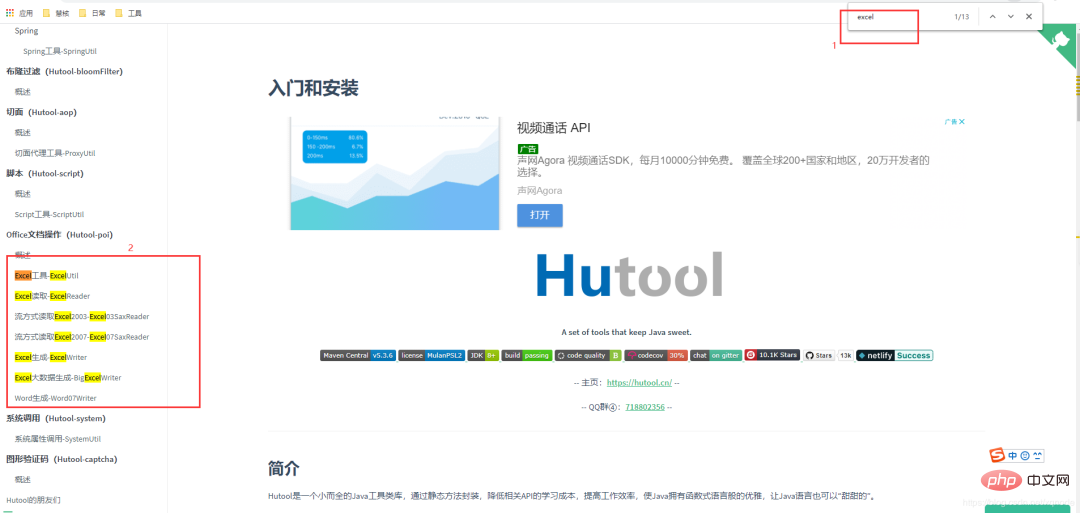
Find ExcelUtil and click on it. :


After opening it, it still feels familiar. The operation is over:
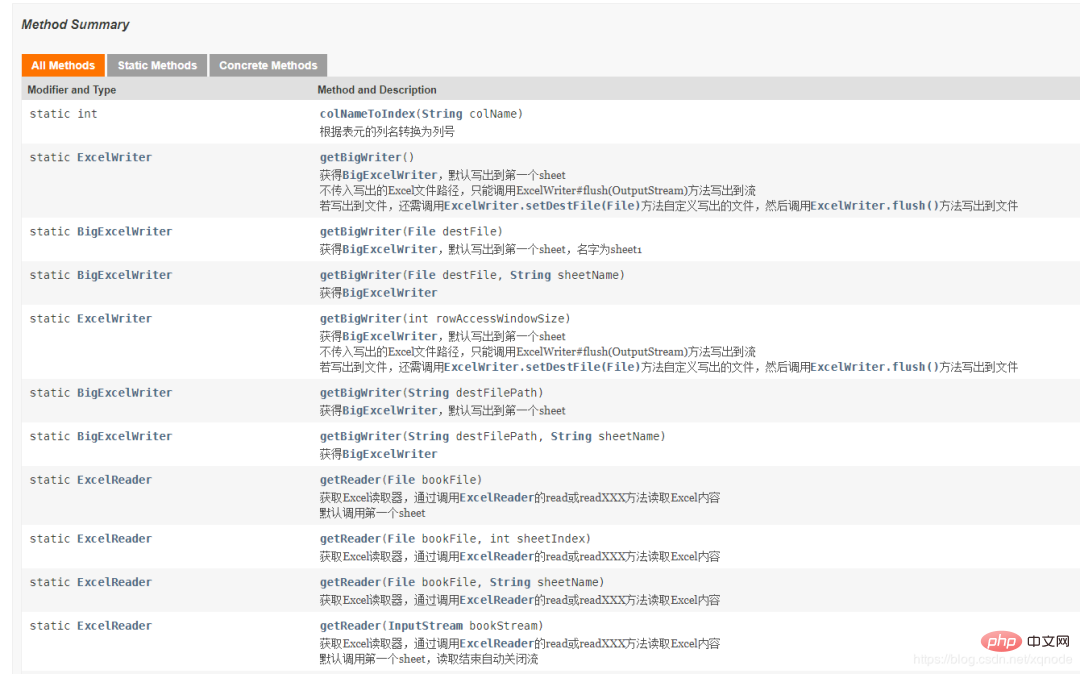

Let me get the string manipulation tool class
StrUtilFor example: How about it? Are domestic tools sweet enough? Why don't you hurry up and try this special June 1 gift? The above is the detailed content of Other children are celebrating Children's Day, so let me recommend a super sweet tool. For more information, please follow other related articles on the PHP Chinese website!import cn.hutool.core.util.ArrayUtil;
import cn.hutool.core.util.StrUtil;
public class HutoolTest {
public static void main(String[] args) {
// String 操作
String str = "hello_word";
System.out.println(StrUtil.isBlank(str)); // 判断字符串是否为空
System.out.println(StrUtil.toCamelCase(str)); // 字符串“_”转驼峰
System.out.println(StrUtil.concat(true, str, null, "123")); //字符串连接
System.out.println(ArrayUtil.toString(StrUtil.splitToArray(str, '_'))); // 字符串拆分数组,内部帮我们做了判断,所以是安全的
}
}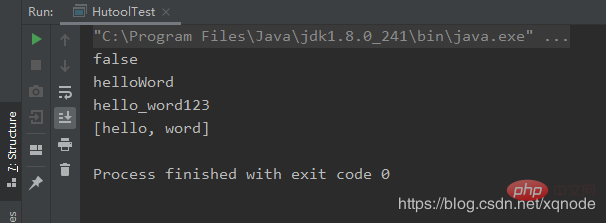 Open the class method diagram of StrUtil and take a look. StrUtil provides us with a very comprehensive tool method for String operations. It can be used out of the box, which is very cool.
Open the class method diagram of StrUtil and take a look. StrUtil provides us with a very comprehensive tool method for String operations. It can be used out of the box, which is very cool. 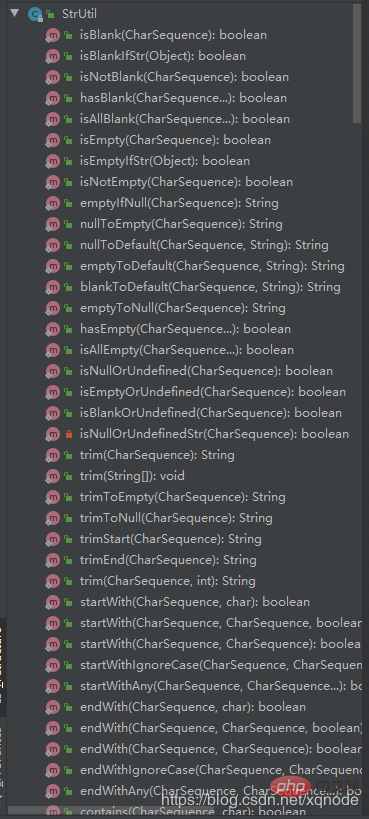
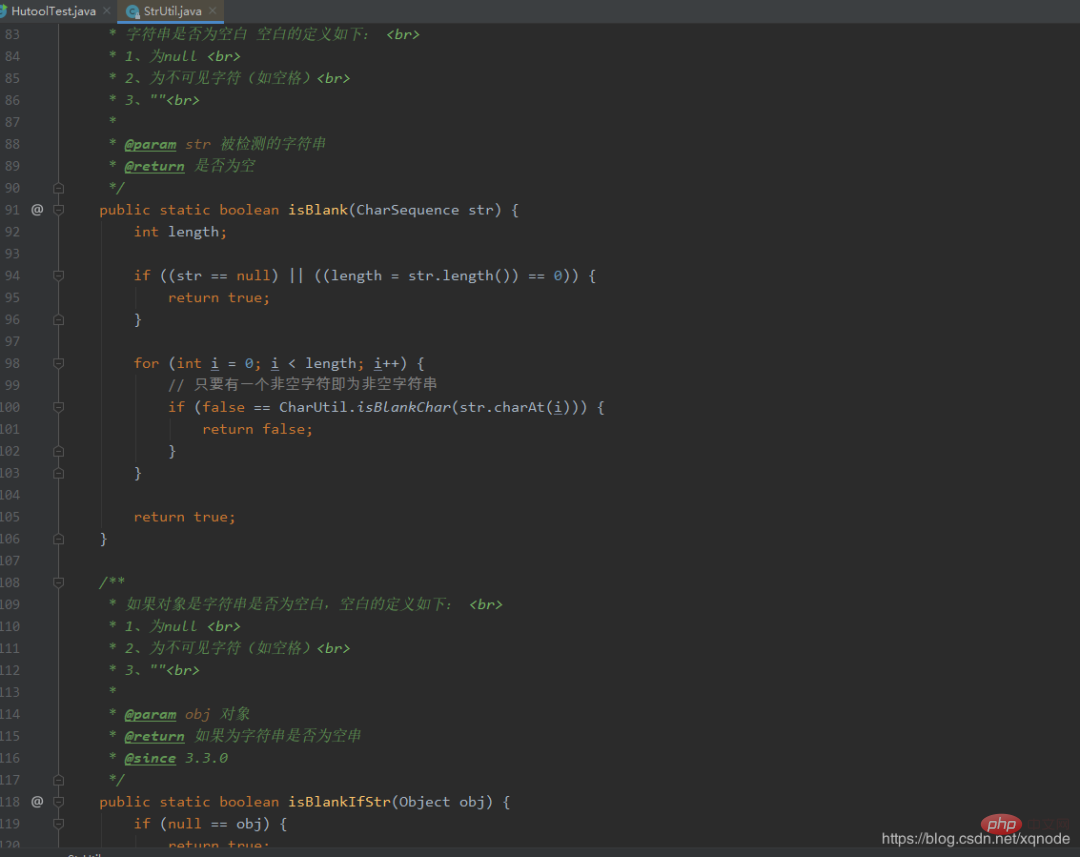

Hot AI Tools

Undresser.AI Undress
AI-powered app for creating realistic nude photos

AI Clothes Remover
Online AI tool for removing clothes from photos.

Undress AI Tool
Undress images for free

Clothoff.io
AI clothes remover

AI Hentai Generator
Generate AI Hentai for free.

Hot Article

Hot Tools

Notepad++7.3.1
Easy-to-use and free code editor

SublimeText3 Chinese version
Chinese version, very easy to use

Zend Studio 13.0.1
Powerful PHP integrated development environment

Dreamweaver CS6
Visual web development tools

SublimeText3 Mac version
God-level code editing software (SublimeText3)

Hot Topics
 1379
1379
 52
52
 How debian readdir integrates with other tools
Apr 13, 2025 am 09:42 AM
How debian readdir integrates with other tools
Apr 13, 2025 am 09:42 AM
The readdir function in the Debian system is a system call used to read directory contents and is often used in C programming. This article will explain how to integrate readdir with other tools to enhance its functionality. Method 1: Combining C language program and pipeline First, write a C program to call the readdir function and output the result: #include#include#include#includeintmain(intargc,char*argv[]){DIR*dir;structdirent*entry;if(argc!=2){
 How to optimize the performance of debian readdir
Apr 13, 2025 am 08:48 AM
How to optimize the performance of debian readdir
Apr 13, 2025 am 08:48 AM
In Debian systems, readdir system calls are used to read directory contents. If its performance is not good, try the following optimization strategy: Simplify the number of directory files: Split large directories into multiple small directories as much as possible, reducing the number of items processed per readdir call. Enable directory content caching: build a cache mechanism, update the cache regularly or when directory content changes, and reduce frequent calls to readdir. Memory caches (such as Memcached or Redis) or local caches (such as files or databases) can be considered. Adopt efficient data structure: If you implement directory traversal by yourself, select more efficient data structures (such as hash tables instead of linear search) to store and access directory information
 How Debian improves Hadoop data processing speed
Apr 13, 2025 am 11:54 AM
How Debian improves Hadoop data processing speed
Apr 13, 2025 am 11:54 AM
This article discusses how to improve Hadoop data processing efficiency on Debian systems. Optimization strategies cover hardware upgrades, operating system parameter adjustments, Hadoop configuration modifications, and the use of efficient algorithms and tools. 1. Hardware resource strengthening ensures that all nodes have consistent hardware configurations, especially paying attention to CPU, memory and network equipment performance. Choosing high-performance hardware components is essential to improve overall processing speed. 2. Operating system tunes file descriptors and network connections: Modify the /etc/security/limits.conf file to increase the upper limit of file descriptors and network connections allowed to be opened at the same time by the system. JVM parameter adjustment: Adjust in hadoop-env.sh file
 Debian mail server SSL certificate installation method
Apr 13, 2025 am 11:39 AM
Debian mail server SSL certificate installation method
Apr 13, 2025 am 11:39 AM
The steps to install an SSL certificate on the Debian mail server are as follows: 1. Install the OpenSSL toolkit First, make sure that the OpenSSL toolkit is already installed on your system. If not installed, you can use the following command to install: sudoapt-getupdatesudoapt-getinstallopenssl2. Generate private key and certificate request Next, use OpenSSL to generate a 2048-bit RSA private key and a certificate request (CSR): openss
 How to use Nginx logs to improve website speed
Apr 13, 2025 am 09:09 AM
How to use Nginx logs to improve website speed
Apr 13, 2025 am 09:09 AM
Website performance optimization is inseparable from in-depth analysis of access logs. Nginx log records the detailed information of users visiting the website. Cleverly using this data can effectively improve the speed of the website. This article will introduce several website performance optimization methods based on Nginx logs. 1. User behavior analysis and optimization. By analyzing the Nginx log, we can gain a deep understanding of user behavior and make targeted optimization based on this: High-frequency access IP identification: Find the IP address with the highest access frequency, and optimize the server resource configuration for these IP addresses, such as increasing bandwidth or improving the response speed of specific content. Status code analysis: analyze the frequency of different HTTP status codes (such as 404 errors), find out problems in website navigation or content management, and proceed
 How to upgrade Zookeeper version on Debian
Apr 13, 2025 am 10:42 AM
How to upgrade Zookeeper version on Debian
Apr 13, 2025 am 10:42 AM
Upgrading the Zookeeper version on Debian system can follow the steps below: 1. Backing up the existing configuration and data Before any upgrade, it is strongly recommended to back up the existing Zookeeper configuration files and data directories. sudocp-r/var/lib/zookeeper/var/lib/zookeeper_backupsudocp/etc/zookeeper/conf/zoo.cfg/etc/zookeeper/conf/zookeeper/z
 How to do Debian Hadoop log management
Apr 13, 2025 am 10:45 AM
How to do Debian Hadoop log management
Apr 13, 2025 am 10:45 AM
Managing Hadoop logs on Debian, you can follow the following steps and best practices: Log Aggregation Enable log aggregation: Set yarn.log-aggregation-enable to true in the yarn-site.xml file to enable log aggregation. Configure log retention policy: Set yarn.log-aggregation.retain-seconds to define the retention time of the log, such as 172800 seconds (2 days). Specify log storage path: via yarn.n
 How Debian OpenSSL prevents man-in-the-middle attacks
Apr 13, 2025 am 10:30 AM
How Debian OpenSSL prevents man-in-the-middle attacks
Apr 13, 2025 am 10:30 AM
In Debian systems, OpenSSL is an important library for encryption, decryption and certificate management. To prevent a man-in-the-middle attack (MITM), the following measures can be taken: Use HTTPS: Ensure that all network requests use the HTTPS protocol instead of HTTP. HTTPS uses TLS (Transport Layer Security Protocol) to encrypt communication data to ensure that the data is not stolen or tampered during transmission. Verify server certificate: Manually verify the server certificate on the client to ensure it is trustworthy. The server can be manually verified through the delegate method of URLSession



